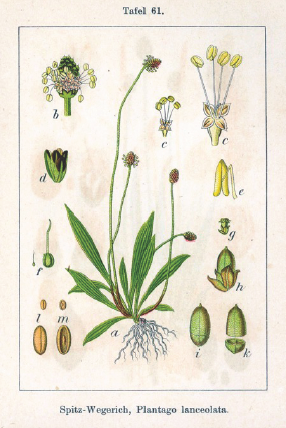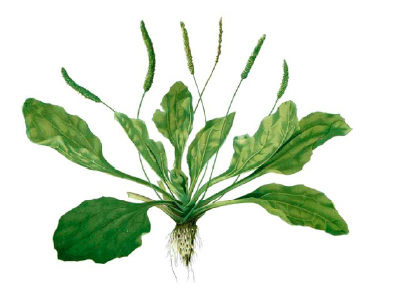My son (who's 5) knows this valuable and humble plant so well. It's saved him from bee stings (twice) and cactus spines in the hand (yeow!). It's one of my favorite ubiquitous herbs – Plantain, and not the banana-shaped kind. Plantain is originally from Europe, most likely brought here intentionally by colonists as medicine and then adopted by First Peoples, who may have already been using native varieties. Plantain is a veritable medicine chest, used both externally for bites and booboos but also for several internal ailments.
Plantago major
Common plantain – “planta” is Latin for sole of the foot, and some liken this to the leaf shape, as well as being a plant that is commonly underfoot. The leaves can also be placed at the sole of the foot to draw away weariness. However, some etymologists suggest the root word is “planus” (as in flat, plane), “platus” (wide), or Celtic “plant” simply meaning, plant or kin.
Image source: Wikimedia
PLANTAIN (Plantago spp)
Lesson: firmly grounded, you will awaken to your strengths and gifts
Offering: protection, humility, awareness
Element & planetary affiliation: Earth, Venus
Energetics: bitter, cool, moist, dry
Sitting there in well trodden paths and lawns all across the planet, this humble warrior of a plant waits to be discovered. To the untrained eye, plantain is just another weed, but to the initiated, it is gold.
For wounds, rashes, and bites
According to Nicholas Culpeper, 17th century renegade herbalist, “All plantains are good wound herbs to heal fresh or old wounds, or sores, either inward or outward.” Got a mosquito bite? Here’s your field medicine. Chew up a leaf and spit it out. Place it on the wound. There you have a spit poultice, a primitive and effective method of applying an herbal remedy. The stinging, itching, irritation and inflammation are relieved. Keep applying until the symptoms have abated.
A salve or balm made with plantain-infused oil can soothe rashes, eczema, and hemorrhoids. Its ability to both draw away poison and relieve skin with moistening mucilage also make plantain a go-to for snake bite. The clue for this is in its flower or seed stalk, reminiscent of a snake about to strike. This is the beauty of the Doctrine of Signatures, an ancient system for identifying the usefulness of plants for healing. (Snakeweed is also one of its common names.)
Soothing to the inside, too
Internally, plantain is a wonder. Soothing an irritating cough and sore throat, plantain is an ally for those suffering from bronchitis and pneumonia. Plantain simultaneously tightens the tissues, lubricates mucous membranes, and draws away unwanted fluids (mucus, pus). Taken tonically (in larger doses over a period of weeks or months), plantain tones the kidneys and liver, and regulates the digestive and urinary tracts. According to herbalist Matthew Wood, this herb is also helpful for oral inflammation and pain. Herbalist Julia Graves says that it is one of the most useful remedies for trigeminal neuralgia (pain that can stem from dental maladies).
A very useful “weed”
Plantain has sprouted up wherever colonialist Europeans set foot, hence the nickname “White man’s footstep.” This now overlooked plant was included in the old English Nine Herbs Charm (10th C. C.E.) depicting 9 of the most important healing plants for poisoning and infection. From North America to New Zealand, indigenous, land-based peoples all the world round found the value of plantain as well. There are also species of plantain native to this content (eg, P. rugelii) – potentially 24 of them! – which First Peoples most likely used prior to the introduction of the European species.
There are several species of Plantago found throughout the world. Two of the most common seen here in the northeast are the introduced species P. major (common or broadleaf plantain) and P. lanceolata (long or lance leaf plantain) and they tend to prefer disturbed soils, which is likely why they are so common here. They are used interchangeably, though my sense is with its smoother, thicker leaves P. major has more mucilage. Its seeds are also more plentiful for use as a fiber supplement. These can be dried and added to baked goods to add bulk and aid digestion.
Flower essence
According to herbalist Anne McIntyre, plantain flower essence “is said to enhance enjoyment of life and with its grounding effect, it promotes strength and stability.”
Image source: WNMU
MORE ABOUT PLANTAIN
Constituents
flavonoids, mucilage, tannins, acids (including vitamin C), allantoin, bitters, fixed oils, sugars, minerals (potassium, calcium)
Actions
alterative, anodyne, anticatarrhal, antimicrobial, antipruritic, antitussive, aperient, astringent, demulcent, diuretic (mild), emollient, hemostatic, mucilaginous, styptic, tonic, vulnerary
Conditions
bites/stings (bees, mosquitos, snakes), bladder infection, bronchitis, conjunctivitis, constipation, cough, diarrhea, eczema, hemorrhoids, hepatitis, kidney inflammation/swelling, oral pain & inflammation, neuralgia, pneumonia, rash, sprains & strains, urinary discomfort, vaginal discharge, wounds
Botanical Description
From a Modern Herbal (Maud Grieve), of Plantago major:
“It grows from a very short rhizome, which bears below a great number of long, straight, yellowish roots, and above, a large, radial rosette of leaves and a few Iong, slender, densely-flowered spikes. The leaves are ovate, blunt, abruptly contracted at the base into a long, broad, channelled footstalk (petiole). The blade is 4 to 10 inches long and about two-thirds as broad, usually smooth, thickish, five to eleven ribbed, the ribs having a strongly fibrous structure, the margin entire, or coarsely and unevenly toothed. The flower-spikes, erect, on long stalks, are as long as the leaves, 1/4 to 1/3 inch thick and usually blunt. The flowers are somewhat purplish green, the calyx four parted, the small corolla bell shaped and four-lobed, the stamens four, with purple anthers. The fruit is a two-celled capsule, not enclosed in the perianth, and containing four to sixteen seeds.”
Plantago major
Image source: Magic Screeches
Plantago lanceolata
Image source: Wikimedia
RECIPES
Plantain Infusion
Place a handful (about 1/4 cup) of dried plantain in a quart jar. If using fresh herb, double the amount. Pour boiling water over and cover. Steep for at least 20 minutes, up to 8 hours (I like to make my infusions overnight). Strain and enjoy!
~~~~
Plantago Chips
From Leda Meredith
http://ledameredith.com/foraging-plantain-leaves-for-food-and-medicine-no-not-that-plant/
These chips are all about texture, I have to admit: the leaves themselves are somewhat bland. But they are a perfectly crisp vehicle for whatever seasoning you put on them. Amounts here are flexible – you can change the number of leaves, amount of salt, etc.
24 large leaves of any Plantago (plantain) species
2 teaspoons olive oil
1/4 teaspoon salt
1/2 teaspoon seasoning (try garlic powder, nutritional yeast, half the quantity of cayenne,
za’atar, or any of your favorite spice blends)
Preheat the oven to 250F. Wash the plantain leaves and dry them well in a salad spinner or by rolling them up in a clean dishtowel.
In a large bowl, toss the leaves with the oil until they are each well coated. Spread the leaves in a single later on baking sheets. Depending on the size of the leaves you gathered, you may need more than one baking sheet.
Sprinkle the leaves with the salt and seasoning. Bake until crisp but not burnt, which may take anywhere from 10 to 20 minutes depending on the size of the leaves. Remember that they will continue to crisp up a bit as they cool, just like cookies do after you take them out of the oven. If you aren’t sure if they’re done, err on the side of underdone. Take them out, let them cool for just a minute, and if they’re not crunchy enough put them back in the oven.
Once they are completely cooled, you can store your Plantago chips in an airtight container for several weeks. If the container is not airtight the chips may absorb some humidity from the air and lose their crispness. Not a problem: simply put them back into a 250F oven for 3 – 5 minutes.
~~~~
Plantain Oil & Salve
About 8 ounces (volume) fresh plantain leaves
About 8 ounces olive or sesame oil
1 ounce beeswax
About 1/4 teaspoon vitamin E oil (optional)
10 to 20 drops lavender essential oil (optional)
Slow method
Harvest fresh large leaves of Plantago major, enough to fill an 8 ounce jar to the top. Tear the leaves into small pieces, about the size of a dime (even a bit smaller). Cover the herbs in the jar with good quality olive or sesame oil. Stir the mixture to get all the bubbles out. Top off the jar with more oil. Cover with some muslin or cheesecloth and secure with a rubber band or metal mason jar band (if that’s the kind of jar you are using). Let the mixture sit in a sunny spot for at least 2 weeks before straining. Check for mold (if you see it, just skim it off the top) – if the plantain is submerged in oil you shouldn’t see any.
Quick method
Tear or cut up the leaves of fresh plantain and place in a glass Pyrex measuring cup or bowl. Cover with oil. In a double boiler fashion, place the measuring cup or bowl over a pot with some water at the bottom. Turn the heat to low-medium. Let the water under the mixture steam but not simmer or boil. Keep stirring the mixture every now and then. Warm the mixture in the double boiler for at least 2 hours. For a really strong infusion, heat it this way for 2 hours on and off for a 24 to 48 hour period (excepting the time when you’re sleeping!). Strain the mix and store in a dark glass jar for 1 to 2 years.
Salve
After straining the oil, pour it into a Pyrex measuring cup, add the beeswax and gently heat in a double boiler fashion. Check and stir occasionally until the beeswax is completely melted and incorporated. Remove mixture from the heat. Let the mixture cool until it is thick but pourable. Stir in Vitamin E oil and essential oil, if desired (they both add skin healing and preservative qualities). Pour the finished mixture into tins or small dark glass jars. Salves can last up to 3 years if stored in a cool, dry place.
Notes: Dried plantain leaves could be used as well. Just use about 1/4 to 1/2 the amount that you would fresh.
Image source: Magic Screeches
POETRY/SONGS/LORE
from Hiawatha
by Henry Wadsworth Longfellow
Wheresoe’er they tread, beneath them
Springs a flower unknown among us,
Springs the White-man’s Foot in blossom.
excerpt from the Nine Herbs Charm
from the Lacnunga
translated from Old English
And you, Plantain, mother of herbs,
Open from the east, mighty inside.
Over you chariots creaked, over you queens rode,
Over you brides cried out, over you bulls snorted.
You withstood all of them, you dashed against them.
May you likewise withstand poison and infection
And the loathsome foe roving through the land.
anecdotes from A Modern Herbal
by Maud Grieve
“Erasmus, in his Colloquia, tells a story of a toad, who, being bitten by a spider, was straightway freed from any poisonous effects he may have dreaded by the prompt eating of a Plantain leaf.”
“From the days of Chaucer onwards we find reference in literature to the healing powers of Plantain. Gower (1390) says: 'And of Plantaine he hath his herb sovereine,' and Chaucer mentions it in the Prologue of the Chanounes Yeman. Shakespeare, both in Love's Labour's Lost, iii, i, and in Romeo and Juliet, I, ii, speaks of the 'plain Plantain' and 'Plantain leaf' as excellent for a broken shin, and again in Two Noble Kinsmen, I, ii: 'These poore slight sores neede not a Plantin.' His reference to it in Troilus and Cressida, III. ii: 'As true as steel, as Plantage to the moon,' is an allusion that is now no longer clear to us. Again, Shenstone in the Schoolmistress: 'And plantain rubb'd that heals the reaper's wound.’”
Long-leaf Plantain (Plantago lanceolata)
Image source: Magic Screeches
FURTHER READING
Wood, Matthew. The Earthwise Herbal: A complete guide to old world medicinal plants. North Atlantic Books. 2008.
Grieve, Maud. A Modern Herbal. Plantain, Common. https://www.botanical.com/botanical/mgmh/p/placom43.html
Keeler, Kathleen. A Wandering Botanist. Plant Story: Plantains (Plantago), Tracking Your
Footsteps All Over the World. http://khkeeler.blogspot.com/2013/11/plant-story-plantainsplantago-tracking.html






